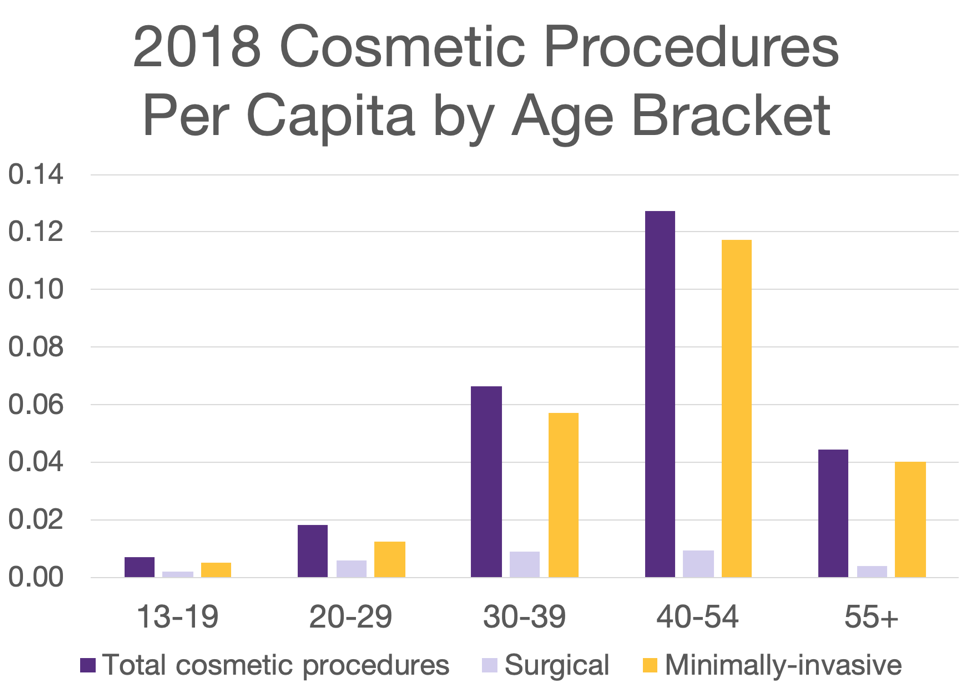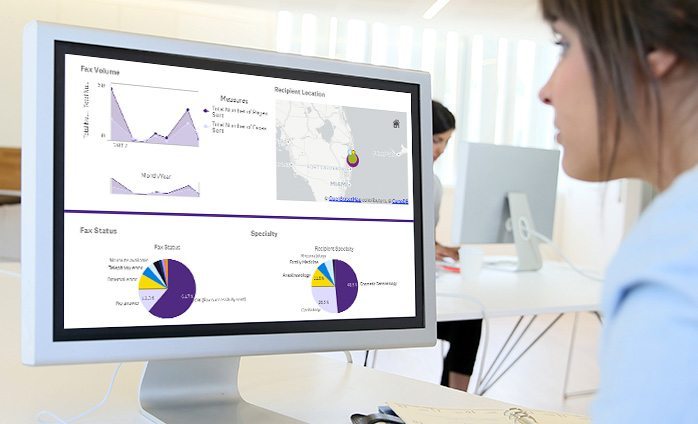Plastic Surgery Marketing Ideas: Using Analytics Software to Help Find Cosmetic Revenue Opportunities

Some strategies for reaching your target market with data-driven plastic surgeon marketing campaigns
Plastic surgery market values and reimbursement rates are largely beyond our control. However, revenue can be increased by making sure your patients are taking advantage of your full range of services.
According to the American Society of Plastic Surgeons (ASPS), there were 17.7 million cosmetic procedures in 2018—up 2 percent from the year before. It’s apparent that patients are having these procedures done. How do you make sure they are staying in your practice?
1. Build your brand.
As a plastic surgeon, you probably already know how important it is to build your unique personal brand—not to mention the importance of marketing for engaging your existing patient base.
Determine your voice and how you want yourself, your staff and the overall patient experience portrayed both on and offline. Regardless of what’s unique to your personal brand, it should conjure a feeling of trust from both current and future patients. Perhaps your tone, both in person and in marketing materials, incorporates the direct yet caring disposition you have with patients. When speaking with patients, provide the relevant clinical information and then make it more accessible to the patient by providing a relatable metaphor.
Your logo, office decor, colors and even how you and your staff dress all contribute to your overall image. Your marketing initiatives and bedside manner with your patients should complement each other. Remember, your online persona may be the first impression and taste of your brand that potential patients may experience before they even decide to pick up the phone.
2. Know your audience.
The types of procedures you offer will depend greatly on who your patients are. With the right tools like a plastic surgery analytics platform, you can analyze your patient demographics to help you identify which services may be most beneficial for your patients.
At a glance, you can parse your patients by zip code, age, ethnicity and more.You can then narrow down your results by facility and provider. You can even look at new patients who have come in within the past two years or at existing patients who haven’t been back this year.
Once you have a sense for what your patient demographics are, you can target cosmetic procedures that will interest and benefit them.
When we combine 2018 data from the American Society of Plastic Surgeons (ASPS) with US Census Bureau estimates, we see which age groups are most likely to undergo cosmetic procedures:

The 40-54-year-old group is more interested in cosmetic procedures than all other groups. Minimally-invasive procedures outnumber surgical ones in every subgroup.
What does this mean for you?
It depends on your focus, experience, and passion. Is your patient and case mix what you want? Where are the areas for growth? What are the other treatments your patient mix would want. Do you need to attract a different demographic?
Also, consider local competition— both by core specialties and others. Ask your patients what they are interested in and what else they have done. Ask about specific treatments. Have they heard of them? Who do they know that has had that done?
Use the power of the data in your plastic surgery EMR system to identify your audience.
3. Understand Return on Investment (ROI).
You can use analytics to evaluate the frequency of each procedure in your practice. You can also filter by provider or location, and you can do the same with products
Compare those results with your average revenue per procedure and product. Maybe you’ll find out that your most popular procedure doesn’t actually bring in the most revenue. You should calculate costs per procedure (time, supplies, visit numbers, cost of patient acquisition, financing and credit card costs) versus revenue to determine the affect your bottom line, not just your top line earnings.
You should also consider which procedures have the highest satisfaction rates. Those procedures are more likely to lead to repeat patients as well as referrals.
Look carefully at your patient acquisition costs. Are those billboards helping your bottom line or just your status? Are your pay per click online ads targeting the right demographic? Once they click, what is their behavior on your website?
You can also look at which employees are bringing in the most revenue. Perhaps one is better at talking to patients about skincare, another about breast augmentation, and a third about facelifts. This can help you funnel your office flow to optimize your education and conversion.
4. Get specific.
 -Using the Advanced Clinical Targeting report in Modernizing Medicine’s Analytics software, you can actually generate lists of specific patients who may benefit from specific elective procedures and products.
-Using the Advanced Clinical Targeting report in Modernizing Medicine’s Analytics software, you can actually generate lists of specific patients who may benefit from specific elective procedures and products.
You can choose from dozens of filters, including date of visit, provider, diagnosis, procedure, location, modifier, medication, pathology results, diagnosis, age and past medical history. You also have the option to exclude patients with certain characteristics to further narrow your search.
For example, you could generate a list of female patients over 45 who live in certain zip codes who have had Botox or fillers with your PA to target for an educational seminar about facelifts. Or patients who have had breast implants over a few years old to come in for assessment.
Another important use for the Advanced Clinical Targeting report is to find patients who came in for a consultation but never came back for the procedure. A follow-up message, postcard or survey may revive the consult or help you understand why they never moved forward.
Marketing campaigns: what works (for you)?
As mentioned, using an analytics tool can help you identify subsets of patients so you can better target your marketing initiatives and provide pertinent information. When it comes to marketing options, you will have multiple mediums at your disposal and it may take time to figure out which ones bring both you and your patients the most value. The rule of seven applies with marketing—consumers often have to have multiple touchpoints (seven of them) to consider opting for a service or product. Think about purchasing a car. You probably didn’t walk into a dealership and purchase the first car you saw. The same rings true with a patient deciding on a new physician or evaluating different procedures.
Cosmetic Surgery Marketing Channels
From emails and social media posts to direct mail postcards and digital ads—the marketing tools at your disposal can seem endless. It will take time (along with some trial and error) to figure out the ROI on your marketing efforts.
Taking an integrated marketing approach to reinforce your message across various platforms can help. Placing posters and brochures around your office and having staff call patients, combined with technology such as social media, digital advertising and your website, can help make a bigger impact.
A word of caution—take care to make sure your plastic surgery marketing materials don’t provide patients unrealistic expectations or conflict with your informed consent documents for elective procedures. You want to maintain integrity with your brand and reputation as a surgeon.
You’ll also want to be sure that any targeted or direct marketing campaigns (text, email or similar) are consistent with any authorizations your patients may have signed or directions they have provided related to how they want you to communicate with them.
Messaging Strategies
Now, let’s talk messaging. Again this should align with your brand regardless of the approach you take.
Patient education is a key part of the process. Teach your staff how to highlight procedure, product and other offerings when patients call. Explain options and procedures in a patient-friendly way—it goes a long way.
Using analytics software can help you uncover patients who haven’t come in for more than a year or never followed-up from an initial consultation. By using this information, you can send them a reminder via text (or postcard) to come in for their regular office visit, while also including a short message alerting them of new offerings that would be most relevant.
Relevancy and personalization are key to all marketing efforts, especially in the digital age, and your plastic surgery marketing efforts should be no different. Let’s take offering targeted discounts on self-pay cosmetic procedures as an example. You can offer a discount on rhinoplasty to patients who came in for rhinoplasty consultations but never had the procedure.
In-Person Discussions
It’s all about relationships and the human touch. No technology or tools can truly replace that personal connection. Referencing notes in your plastic surgery EMR software can help remind you to talk to your patients about new procedure or product offerings most relevant to them.
For elective procedures, you can even add a PDF questionnaire for the patient to fill out to gauge their interest and eligibility. Some plastic surgery EMR software systems, like EMA®, allow you to create interactive PDFs to make this even easier.
Follow-Ups
In the months and years after you’ve launched your plastic surgery advertising campaigns, you can really start tracking your return on investment and understand what works best. Continuing to use advertising analytics and insights, as well as feedback gleaned directly from patients, can help identify what resonates not only for you, but for them, too. Consistency and repetition is key and striking that balance without over communicating or annoying your patients can be challenging. It’s a delicate balance. You want to help keep patients informed of potentially beneficial offerings to help drive ancillary revenue and help positively impact patient satisfaction.
Conclusion
The key to effective marketing is establishing brand, understanding your target audience, aligning your offerings and communicating with your target. By informing patients about products and procedures that may benefit them, you can help patients look and feel their best and strengthen your relationships with them while contributing to your bottom line and professional satisfaction.
With analytics tools at your fingertips, it’s easy to identify trends and pinpoint specific patient groups. This can make the marketing process much more effective.




